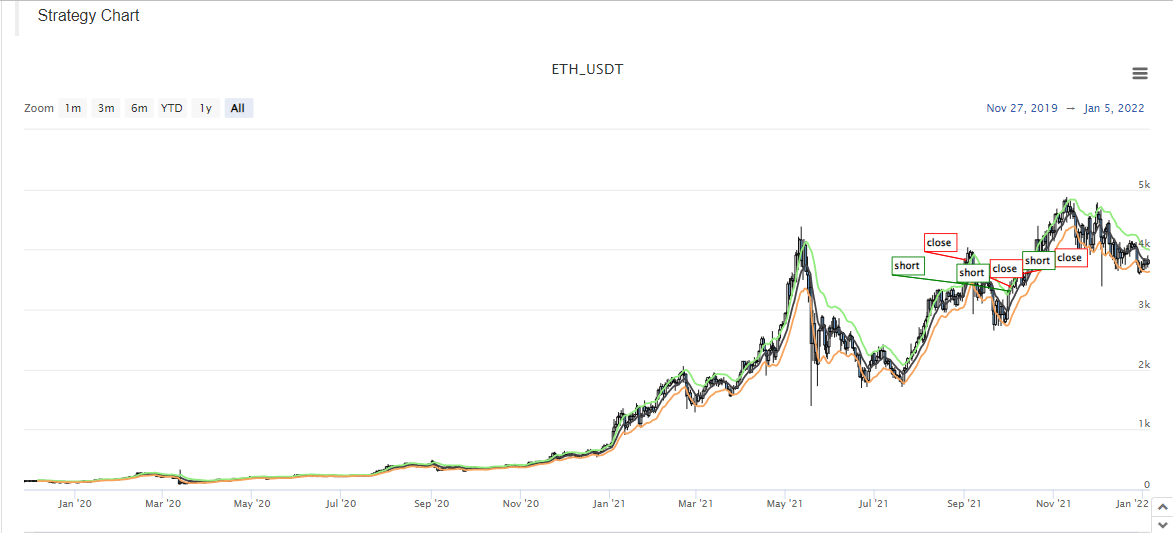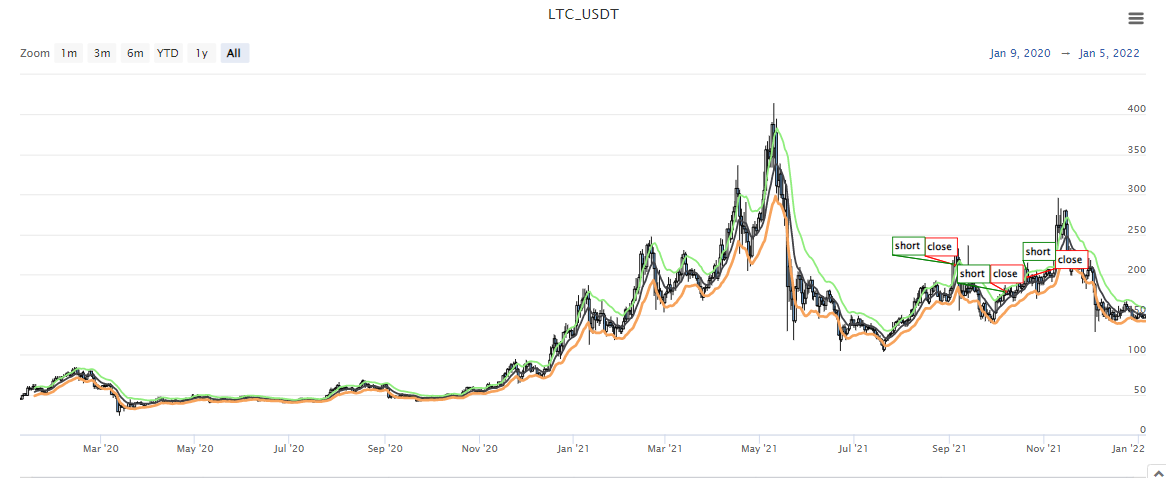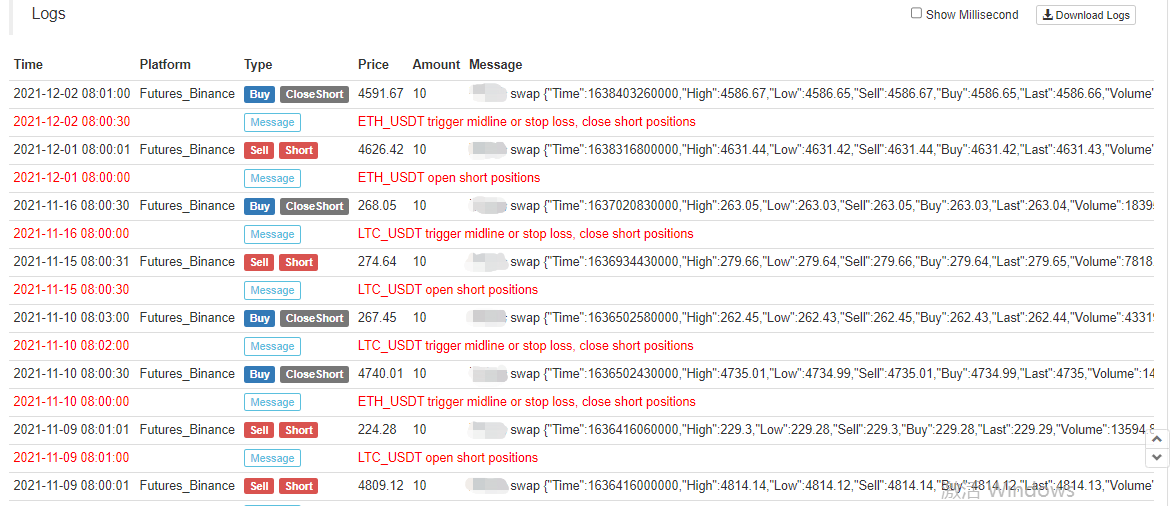Stratégie ATR multi-espèces de contrats à terme sur devises numériques (tutoriel)
Auteur:FMZ~Lydia, Créé: 2022-11-08 10:34:22, Mis à jour: 2023-09-15 20:55:33
Récemment, certains utilisateurs de notre plateforme sont impatients de transplanter une stratégie MyLanguage dans une stratégie JavaScript, ce qui peut ajouter de nombreuses idées d'optimisation de manière flexible. Même étendre la stratégie à des versions multi-espèces. Parce que la stratégie MyLanguage est généralement une stratégie de tendance, et beaucoup d'entre elles sont exécutées sur la base du modèle de prix de clôture. L'interface API de l'échange de requêtes de stratégie n'est pas très fréquente, ce qui convient à la transplantation vers une version de stratégie multi-espèces. Dans cet article, nous prendrons une stratégie MyLanguage simple comme exemple pour la transplanter dans une version simple du langage JavaScript. Le but principal est d'enseigner et de soutenir la recherche.
La stratégie de MyLanguage à transplanter
TR:=MAX(MAX((H-L),ABS(REF(C,1)-H)),ABS(REF(C,1)-L));
ATR:=EMA(TR,LENGTH2);
MIDLINE^^EMA((H + L + C)/3,LENGTH1);
UPBAND^^MIDLINE + N*ATR;
DOWNBAND^^MIDLINE - N*ATR;
BKVOL=0 AND C>=UPBAND AND REF(C,1)<REF(UPBAND,1),BPK;
SKVOL=0 AND C<=DOWNBAND AND REF(C,1)>REF(DOWNBAND,1),SPK;
BKVOL>0 AND C<=MIDLINE,SP(BKVOL);
SKVOL>0 AND C>=MIDLINE,BP(SKVOL);
// stop loss
// stop loss
C>=SKPRICE*(1+SLOSS*0.01),BP;
C<=BKPRICE*(1-SLOSS*0.01),SP;
AUTOFILTER;
La logique de négociation de cette stratégie est simple. Tout d'abord, calculez l'ATR en fonction des paramètres, puis calculez la moyenne des prix les plus élevés, les plus bas et de clôture de tous les BAR de la ligne K, puis calculez l'indicateur EMA en fonction des données moyennes. Enfin, combinez l'ATR et le coefficient N dans les paramètres pour calculer la upBand et la downBand.
Les positions d'ouverture et de vente sont basées sur le prix de clôture. Ouvrez des positions longues lorsqu'il dépasse le upBand et vendez la position d'ouverture (lorsque vous détenez des positions courtes). Ouvrez des positions courtes lorsqu'il dépasse le downBand et vendez la position d'ouverture. Lorsque le prix de clôture atteint la ligne médiane, la position est fermée et lorsque le prix de clôture atteint le prix de stop loss, la position est également fermée (selon le SLOSS, le stop loss est de 1, c'est-à-dire de 0,01, c'est-à-dire de 1%). La stratégie est exécutée selon un modèle de prix de clôture.
OK, si nous comprenons les exigences stratégiques et les idées de MyLanguage, nous pouvons commencer à les transplanter.
Prototype de stratégie de transplantation et de conception
Pour faciliter l'apprentissage des idées d'écriture de stratégie, les commentaires sont écrits directement dans le code de stratégie.
// parse params parameters, and parse strings as objects
var arrParam = JSON.parse(params)
// this function creates a chart configuration
function createChartConfig(symbol, atrPeriod, emaPeriod, index) { // symbol : trading pair, atrPeriod : ATR parameter period , emaPeriod : EMA parameter period, exchange object index corresponding to index
var chart = {
__isStock: true,
extension: {
layout: 'single',
height: 600,
},
title : { text : symbol},
xAxis: { type: 'datetime'},
series : [
{
type: 'candlestick', // K-line data series
name: symbol,
id: symbol + "-" + index,
data: []
}, {
type: 'line', // EMA
name: symbol + ',EMA:' + emaPeriod,
data: [],
}, {
type: 'line', // upBand
name: symbol + ',upBand' + atrPeriod,
data: []
}, {
type: 'line', // downBand
name: symbol + ',downBand' + atrPeriod,
data: []
}, {
type: 'flags',
onSeries: symbol + "-" + index,
data: [],
}
]
}
return chart
}
// main Logic
function process(e, kIndex, c) { // e is the exchange object, exchanges [0]..., kIndex is the K-line data series in the chart, and c is the chart object
// obtain K-line data
var r = e.GetRecords(e.param.period)
if (!r || r.length < e.param.atrPeriod + 2 || r.length < e.param.emaPeriod + 2) {
// if the K-line data length is insufficient, return
return
}
// calculate ATR indicators
var atr = TA.ATR(r, e.param.atrPeriod)
var arrAvgPrice = []
_.each(r, function(bar) {
arrAvgPrice.push((bar.High + bar.Low + bar.Close) / 3)
})
// calculate EMA indicators
var midLine = TA.EMA(arrAvgPrice, e.param.emaPeriod)
// calculate upBand and downBand
var upBand = []
var downBand = []
_.each(midLine, function(mid, index) {
if (index < e.param.emaPeriod - 1 || index < e.param.atrPeriod - 1) {
upBand.push(NaN)
downBand.push(NaN)
return
}
upBand.push(mid + e.param.trackRatio * atr[index])
downBand.push(mid - e.param.trackRatio * atr[index])
})
// draw the chart
for (var i = 0 ; i < r.length ; i++) {
if (r[i].Time == e.state.lastBarTime) {
// update
c.add(kIndex, [r[i].Time, r[i].Open, r[i].High, r[i].Low, r[i].Close], -1)
c.add(kIndex + 1, [r[i].Time, midLine[i]], -1)
c.add(kIndex + 2, [r[i].Time, upBand[i]], -1)
c.add(kIndex + 3, [r[i].Time, downBand[i]], -1)
} else if (r[i].Time > e.state.lastBarTime) {
// add
e.state.lastBarTime = r[i].Time
c.add(kIndex, [r[i].Time, r[i].Open, r[i].High, r[i].Low, r[i].Close])
c.add(kIndex + 1, [r[i].Time, midLine[i]])
c.add(kIndex + 2, [r[i].Time, upBand[i]])
c.add(kIndex + 3, [r[i].Time, downBand[i]])
}
}
// check the position
var pos = e.GetPosition()
if (!pos) {
return
}
var holdAmount = 0
var holdPrice = 0
if (pos.length > 1) {
throw "long and short positions are checked at the same time!"
} else if (pos.length != 0) {
holdAmount = pos[0].Type == PD_LONG ? pos[0].Amount : -pos[0].Amount
holdPrice = pos[0].Price
}
if (e.state.preBar == -1) {
e.state.preBar = r[r.length - 1].Time
}
// check the signal
if (e.state.preBar != r[r.length - 1].Time) { // closing price model
if (holdAmount <= 0 && r[r.length - 3].Close < upBand[upBand.length - 3] && r[r.length - 2].Close > upBand[upBand.length - 2]) { // the closing price cross over the upBand
if (holdAmount < 0) { // hold a short positions, close them
Log(e.GetCurrency(), "close short positions", "#FF0000")
$.CoverShort(e, e.param.symbol, Math.abs(holdAmount))
c.add(kIndex + 4, {x: r[r.length - 2].Time, color: 'red', shape: 'flag', title: 'close', text: "close short positions"})
}
// open long positions
Log(e.GetCurrency(), "open long positions", "#FF0000")
$.OpenLong(e, e.param.symbol, 10)
c.add(kIndex + 4, {x: r[r.length - 2].Time, color: 'red', shape: 'flag', title: 'long', text: "open long positions"})
} else if (holdAmount >= 0 && r[r.length - 3].Close > downBand[downBand.length - 3] && r[r.length - 2].Close < downBand[downBand.length - 2]) { // the closing price cross down the downBand
if (holdAmount > 0) { // hold long positions, close them
Log(e.GetCurrency(), "close long positions", "#FF0000")
$.CoverLong(e, e.param.symbol, Math.abs(holdAmount))
c.add(kIndex + 4, {x: r[r.length - 2].Time, color: 'green', shape: 'flag', title: 'close', text: "close long positions"})
}
// open short positions
Log(e.GetCurrency(), "open short positions", "#FF0000")
$.OpenShort(e, e.param.symbol, 10)
c.add(kIndex + 4, {x: r[r.length - 2].Time, color: 'green', shape: 'flag', title: 'short', text: "open short positions"})
} else {
// close positions
if (holdAmount > 0 && (r[r.length - 2].Close <= holdPrice * (1 - e.param.stopLoss) || r[r.length - 2].Close <= midLine[midLine.length - 2])) { // Hold a long position, the closing price is less than or equal to the midline, stop loss at the opening price
Log(e.GetCurrency(), "trigger midline or stop loss, close long positions", "#FF0000")
$.CoverLong(e, e.param.symbol, Math.abs(holdAmount))
c.add(kIndex + 4, {x: r[r.length - 2].Time, color: 'green', shape: 'flag', title: 'close', text: "close long positions"})
} else if (holdAmount < 0 && (r[r.length - 2].Close >= holdPrice * (1 + e.param.stopLoss) || r[r.length - 2].Close >= midLine[midLine.length - 2])) { // Hold a short position, the closing price is greater than or equal to the midline, stop loss at the opening price
Log(e.GetCurrency(), "trigger midline or stop loss, close short positions", "#FF0000")
$.CoverShort(e, e.param.symbol, Math.abs(holdAmount))
c.add(kIndex + 4, {x: r[r.length - 2].Time, color: 'red', shape: 'flag', title: 'close', text: "close short positions"})
}
}
e.state.preBar = r[r.length - 1].Time
}
}
function main() {
var arrChartConfig = []
if (arrParam.length != exchanges.length) {
throw "Parameters and exchange objects do not match!"
}
var arrState = _G("arrState")
_.each(exchanges, function(e, index) {
if (e.GetName() != "Futures_Binance") {
throw "The exchange is not supported!"
}
e.param = arrParam[index]
e.state = {lastBarTime: 0, symbol: e.param.symbol, currency: e.GetCurrency()}
if (arrState) {
if (arrState[index].symbol == e.param.symbol && arrState[index].currency == e.GetCurrency()) {
Log("restore:", e.state)
e.state = arrState[index]
} else {
throw "The restored data does not match the current settings!"
}
}
e.state.preBar = -1 // initial setting -1
e.SetContractType(e.param.symbol)
Log(e.GetName(), e.GetLabel(), "set contracts:", e.param.symbol)
arrChartConfig.push(createChartConfig(e.GetCurrency(), e.param.atrPeriod, e.param.emaPeriod, index))
})
var chart = Chart(arrChartConfig)
chart.reset()
while (true) {
_.each(exchanges, function(e, index) {
process(e, index + index * 4, chart)
Sleep(500)
})
}
}
function onexit() {
// record e.state
var arrState = []
_.each(exchanges, function(e) {
arrState.push(e.state)
})
Log("record:", arrState)
_G("arrState", arrState)
}
Paramètres de stratégie:
var params = '[{
"symbol" : "swap", // contract code
"period" : 86400, // K-line period, 86,400 seconds is a day
"stopLoss" : 0.07, // stop loss factor, 0.07 or 7%
"atrPeriod" : 10, // ATR indicator parameters
"emaPeriod" : 10, // EMA indicator parameters
"trackRatio" : 1, // upBand and downBand coefficients
"openRatio" : 0.1 // The reserved opening percentage, which is not supported for now
}, {
"symbol" : "swap",
"period" : 86400,
"stopLoss" : 0.07,
"atrPeriod" : 10,
"emaPeriod" : 10,
"trackRatio" : 1,
"openRatio" : 0.1
}]'
Captures d'écran de test arrière:



Le code source de la stratégie:https://www.fmz.com/strategy/339344
S'il vous plaît modifier, optimiser, et se référer au vrai bot par vous-même.
- Nouvelle fonctionnalité de FMZ Quant: Utilisez la fonction _Serve pour créer facilement des services HTTP
- Nouvelles fonctionnalités quantifiées par les inventeurs: créer facilement des services HTTP avec la fonction _Serve
- Guide d'accès au protocole personnalisé de la plateforme de trading quantique FMZ
- Stratégie d'acquisition et de suivi du taux de financement de la FMZ
- Stratégie d'acquisition et de surveillance des taux de financement FMZ
- Un modèle de stratégie vous permet d'utiliser WebSocket Market de manière transparente
- Un modèle de stratégie vous permet d'utiliser WebSocket sans heurts
- Guide d'accès au protocole général pour les plateformes de négociation quantitative pour les inventeurs
- Comment construire une stratégie de trading multi-monnaie universelle rapidement après la mise à niveau FMZ
- Comment construire rapidement une stratégie de trading monétaire universelle après la mise à niveau de FMZ
- Commerce de DCA: une stratégie quantitative largement utilisée